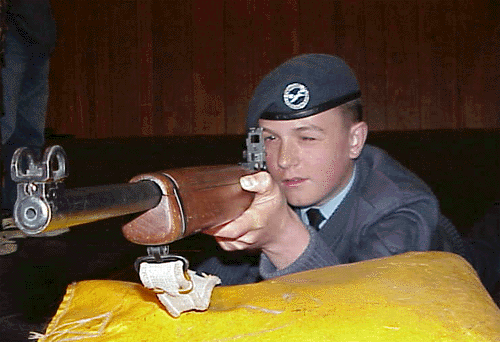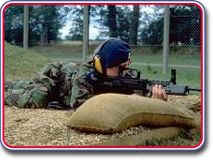

Welcome to My Shooting Page.
Some cadets like shooting, some don't. If you don't, then don't worry. You're not the only one.
As a cadet you will get the chance to shoot the .22 rifle (like ones used by soldiers in dad's army), the L98 - cadet version of the SA80 (seen on the soldiers who go to Bosnia etc), if you're very lucky, the L81.
Shooting takes place at either a cadet hut range or a military range such as Carver Barracks in Colchester, RAF Honnington, RAF Odiham etc etc.
Most of the L98 live firing will take place at one of the RAF 25mtr ranges located on most RAF stations. Occasionally the cadets get the opportunity to fire the weapon on an outdoor gallery range firing at distances up to 500mtrs. The first few times a cadet fires the rifle they will have a safety coach with them to assist with any problems and coach in the general handling of the rifle. Once the cadets show competence in handling the rifle they can go on to achieve their ATC Marksmanship badge and even the RAF Marksmanship award.



Awards and Recognition
As you become more experienced shooting with the rifle, you will have the chance to compete in tournaments and gain recognition for your abilities. As well as the tournaments, there are three different badges that a cadet can qualify for:
ATC Marksman
- To achieve the ATC Marksman, the cadet must fire five rounds into a target from 25 meters, all of which must hit an area of 1" inch diameter. This award is also taken using the Number 8 weapon.The ATC Marksman badge is to be worn at the bottom of the brassard in the center.
RAF Marksman
- This is much harder and is taken using the more powerful L-98 rifle. You must complete three sections:The RAF Marksman badge is to be worn in the place of the ATC Marksman badge.
Cadet 100
- To achieve the Cadet 100 badge you must enter the tri-service shooting competition held annually at Bisley and achieve a score that puts them in the top 100 cadets attending. This competition can be difficult, especially as you are facing the Army Cadet Force (ACF) and Sea Cadet Corps (SCC) and the ACF practice shooting a lot.
Shooting Techniques
To fire well and accurately, you must follow several discipline. These are detailed below.
1. Breathing
Before firing, roughly line up the sight with the target. When you are ready to
fire, take half a breathe, hold it, and when you are ready, fire off the round.
This ensures that the rifle is held steadily when fired.
2. The Trigger
This has to be treated gently. Inexperienced shooters have a tendency to
"snatch" at the trigger by squeezing it too quickly. The correct
method is to gently move the trigger back to the first pressure, and then gently
and slowly pull the trigger back - causing the rifle to fire. Doing this ensures
that you are more stable and, prepares you for any recoil.
3. The Grip
Rifles are made of metal and wood and so are not easy to break! They should be
treated strongly. When holding the rifle, pull it tightly into your shoulder,
grip it firmly, and expect the recoil. This is not excessive, but is enough to
send your round over the target if you are not prepared for it.
4. Lining up
To line-up the target correctly, first look down the sight. Then, bringing this
to the same height as the center of the target, pause for a second then and move
the rifle along to the center of the target. Remember this position and you will
shoot well.
These are not guaranteed to get you good results, but should, with practice, improve your shooting. Each person gains experience as they fire more, so the more you shoot, the better you will become.
Types of Fire
While on the range, depending on what rifle you are using, you will be experimenting with one or more of the following firing practices.
Grouping
In a grouping, the fire selects a single point on the target and continually fires several rounds at that point. The aim of a grouping is to get all the rounds as close to the aim point as possible. Grouping can be the ideal time to perfect your firing technique. There is no time limit on a grouping.
Deliberate Fire
The aim of deliberate fire is to place the shots as close as possible to the center of the 'bulls eye' target. Scoring depends on how near to the center the shots are fired. The most used target on deliberate fire is a large piece of card with up to 10 separate targets on them. When firing at a card with multiple targets, the shooter should aim to get one or two rounds in each of the targets. Shooters can take as long as they want to make the shots.
Rapid
With rapid fire the aim is simple. Get all the rounds into the target. However, this time they now have a time limit to complete the shot, for example 5 rounds in 20 seconds.
Snap
During snap fire, the shooter once again needs to hit the target with the rounds. This time however, the targets are only visible to the shooter for a short length of time before the disappear again. The aim of snap fire is to usually get two rounds each time it is visible. The target will appear at random times so the shooter cannot predict it.
Rifle Training
The first rifle that a cadet will fore is the No. 8 bolt action rifle. This rifle is a modified version of the Enfield No. 4 rifle used in World War II. Each round must be fed into the chamber manually which is a very time consuming act. However, cadets will not be allowed near a rifle until they have completed their dry training.
During dry training, cadets will be shown the No. 8 rifle in great detail. They will learn of the commands and regulations used while on the range and also what is expected of a cadet on the range and what to expect when they first go down there. After the cadet has passed the Weapon Handling Test, only then a cadet can go on the range and fire live ammunition.
The No. 8 rifle is an ideal for a cadet who has never fired a rifle before. It is simple to use which makes it superlative for training. There is very little noise from the weapon when the bullet is discharged although ear defenders are compulsory when on a range in operation.
The L98 Rifle
Cadets over the age of 14 years and are qualified to fire the No. 8 rifle may fire the L98 Cadet rifle. The rifle is a modification of an existing weapon, the SA80 automatic rifle, the primary weapon of the British Army. It fires the same ammunition as the L85 but has been modified from the SA80 so that it is not automatic and has to be manually cocked for each round. With the L98, the ammunition is fed into the chamber through a magazine which stores up to ten rounds rather than manual feeding.
As the weapons operation is different to that of the No. 8 rifle, cadets have to undergo additional dry training for the L98. One of the major differences of the L98 and the No. 8 is that the higher caliber rounds of the L98 can be felt (and heard) more as you pull the trigger.
Before the cadets are allowed to fire the L98 rifle they have to complete a
minimum of 8 hours dry classroom training.
Due to the complexity of the rifle the drills must be learnt by the cadets to
enable them to safely handle the weapon in every eventuality.
At the end of their dry classroom training they must take a test to prove
competency in handling the rifle. The test is very strictly governed to ensure
the highest degree of safety for both the cadet and other personnel present
during the live firing.
This Rifle is based upon the L85 (commonly referred to as the SA80) which is
the standard issue rifle for British Service personnel.
It has been modified for cadet use, mainly having the semi & full auto modes
removed from it and having a cocking handle fitted so that the cadets can only
fire one round at a time, cocking the rifle each time to eject the dispensed
round and loading a new one. It is magazine fed, holding a max of 30
rounds of 5.56 center fire ammunition.